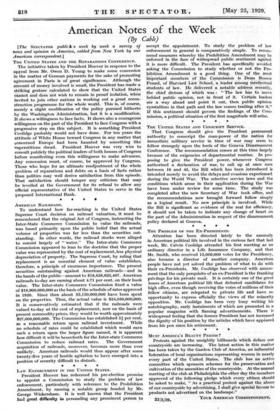To understand how far-reaching is the United States Supreme Court
decision on railroad valuation,' it must be remembered that the original Act of Congress, instructing the Inter-State Commerce Commission to value the railroads, was based primarily upon the public belief that the actual volume of properties was far less than the securities out- standing.. In other words, the railroad stocks were alleged to consist largely of " water." The Inter-state Commerce Commission appeared to lean to the doctrine that the proper value was represented by the cost of replacement, less physical depreciation of property. The Supreme Court, by ruling that replacement is an essential element of value establishes, therefore, a principle of enormous importance. The present securities outstanding against American railroads—and in the hands of the public—amount to $18,658,623,487. American railroads to-day are earning about 4.71 per cent. on their book value. The Inter-state Commerce Commission fixed a value of $18,900,000,000 as the basis of the schedule of rates approved in 1920. Since then about $5,150,000,000 have been spent on the properties. Thus, the actual value is $24,050,000,000. It is conservatively estimated that if the railroads were valued to-day at the cost of replacement, now on the basis of present commodity prices, they would be worth approximately $27,000,000,000. The Commission has established 5f per cent. as a reasonable return upon railroad investment. While no schedule of rates could be established which would earn such a return upon the larger figure named, it is apparent how difficult it will be henceforth for the Inter-state Commerce Commission to reduce railroad rates. The Government acquisition of railroads, moreover, becomes more than ever unlikely. American railroads would thus appear after some twenty-five years of hostile agitation to have emerged into a position of security difficult to disturb.
* * * *








































 Previous page
Previous page